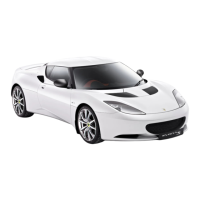
Do you have a question about the Lotus Evora 2011 and is the answer not in the manual?
| Brand | Lotus |
|---|---|
| Model | Evora 2011 |
| Category | Automobile |
| Language | English |
Identifies and describes all controls and indicators on the vehicle's dashboard and fascia.
Provides guidance on environmentally conscious driving practices and vehicle operation.
Explains the procedure for reporting vehicle safety defects to the authorities.
Details the specific location of the engine's serial number for identification purposes.
Describes the function and components of the vehicle's transmitter keys and security system.
Explains how to arm, disarm, and manage the vehicle's security alarm system.
Covers battery replacement, emergency disarming, and programming of transmitter keys.
Details the operation of the central door locking and related functions like drive-away locking.
Explains manual locking procedures and the safety inertia switch function.
Provides instructions on adjusting front seats and accessing the rear cabin.
Guides on proper seat belt use, precautions, and tell-tale indicators.
Explains the SRS, its operation, tell-tale indicators, and safety warnings.
Offers guidance on safely installing child seats and related safety measures.
Addresses specific considerations for drivers or passengers with disabilities.
Covers interior and exterior mirror adjustments, heating, and fold-flat options.
Explains the operation of electric windows, including auto-drop and closure features.
Details interior lamp operation, glovebox access, and sun visor usage.
Describes the function of the ignition switch and steering column lock mechanisms.
Covers speedometer, tachometer, odometer, information screens, and tell tale lamps.
Details lighting, hazard, wiper, horn, illumination, and steering column controls.
Explains the basic operation of the climate control system and vents.
Details air distribution, temperature, fan speed, and re-circulation settings.
Covers heated screens, demist/defrost, and air conditioning requests.
Describes heated seat operation and engine bay cooling systems.
Details the location and usage of auxiliary power outlets in the cabin and trunk.
Explains the function of foot pedals and proper clutch usage.
Describes the footbrake, ABS, HBA, EBD, and EDL systems.
Covers the operation of the parking brake and the manual gear lever.
Explains Lotus DPM, Sport Mode, Cruise Control, and Homelink functions.
Outlines operating temperature limits and procedures for starting cold or warm engines.
Provides guidelines for engine break-in and proper engine shutdown.
Highlights unique engine technologies and characteristics of the Evora models.
Details recommended fuel types and the process for refueling the vehicle.
Covers tailgate opening, closing, manual release, and front body access hatch.
Provides guidance on maintaining the vehicle's bodywork, paint, and interior materials.
Outlines essential maintenance checks that owners can perform.
Details engine oil level checks, oil changes, and filter replacement procedures.
Covers servicing for transmission, cooling, washer, and brake fluid systems.
Explains inspection procedures for brake pads and pipes/hoses.
Covers maintenance for air filters, drive belts, and spark plugs.
Provides glossary terms, safety advice, care instructions, and characteristics of tires.
Explains the use and limitations of the tire repair aerosol kit.
Details wheel types, bolt torque, alignment, and replacement procedures.
Covers battery access, disconnection, reconnection, charging, and jump-starting procedures.
Identifies the location and function of fuses and relays in the vehicle's electrical system.
Details headlamp alignment and bulb replacement procedures for various lights.
Explains how to use the recovery eye and tie-down methods for towing.
Guides on safely lifting the vehicle using a jack and identifying proper jacking points.
Discusses fitting accessories and potential safety impacts of modifications.
Provides recommendations for storing the vehicle for extended periods.
Specifies engine oil types, grades, and severe service conditions.
Lists recommended fluids and change intervals for transmission, brakes, and power steering.
Details the type, concentration, and change interval for engine coolant.
Provides data on tire types, sizes, pressures, wheel specs, and bolt torque.
Lists key vehicle dimensions and fluid capacities.
Details engine specifications, ignition, and brake system components.
